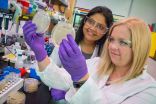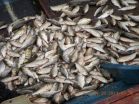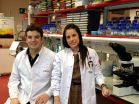Engineered for tolerance, bacteria pump out higher quantity of renewable gasoline
2014-11-05
(Press-News.org) WASHINGTON, DC—November 4, 2014—An international team of bioengineers has boosted the ability of bacteria to produce isopentenol, a compound with desirable gasoline properties. The finding, published in mBio®, the online open-access journal of the American Society for Microbiology, is a significant step toward developing a bacterial strain that can yield industrial quantities of renewable bio-gasoline.
The metabolic engineering steps to produce short-chain alcohol solvents like isopentenol in the laboratory bacteria Escherichia coli have been worked on extensively by many research groups, explains Aindrila Mukhopadhyay, director of host engineering at the Joint BioEnergy Institute in Emeryville, California and senior author on the study.
"Biofuels are one tool in the array of alternative energy solutions that can be used in our infrastructure immediately," she says. Sustainably produced fuel compounds can be added directly into gasoline blends used today to offset reliance on fossil fuels and also lower the net carbon emissions from vehicles.
"But the solvent-like compounds inhibit microbial growth and that was an aspect that we realized would come up sooner rather than later," says Mukhopadhyay, who holds a joint appointment at Lawrence Berkeley National Laboratory. "We wanted to look at that aspect with a systems biology approach — could we engineer bacteria to also tolerate the solvent it is producing?"
Improving tolerance is key to moving production toward levels that are industrially relevant. Industrial production requires a robust strain that can stably produce for longer periods of time and withstand the accumulation of the solvent-like biofuel.
To address this challenge, the team, which also included researchers from Nanyang Technological University in Singapore, National University of Singapore, and the University of California, Berkeley, treated a non-producing E. coli strain with isopentenol by adding it to the culture. As the bacteria responded to the solvent-stressor, the team measured which genes were shifted up or down by looking at messenger RNA transcripts across the entire genome.
They chose 40 genes that the bacteria cranked up in response to isopentenol—presumably because their actions helped mitigate the toxicity in some way. Next, they overexpressed each one in a bacterial strain actively producing isopentenol to see which ones might improve the strain's growth.
Of the eight genes that rescued growth, two stood out as promising—MetR, a biosynthesis regulator, that improved isopentenol production by 55%, and MdlB, a transporter, that improved production by 12%. If the researchers bumped up the levels of the MdlB transporter protein inside the cells even further, they saw production improve by as much as 60% over the original strain.
"Finding a transporter really appealed to us because it has the potential to export the final solvent product out of the cell," says Mukhopadhyay. "And in this case, once enough alcohol gets outside the cell, it might phase separate and not even be accessible to the organism anymore." In other words, the biofuel would separate away to sit atop the watery broth the bacteria live in.
As an added bonus, the MdlB protein is a good candidate for directed evolution experiments that could improve the performance and specificity of the transporter for shuttling isopentenol out as quickly as possible. Combining a more efficient transporter with other genes that improved tolerance might produce a strain that can generate bio-gasoline for the gas pump in the near future.
INFORMATION:
This research was supported by the U.S. Department of Energy and the National Research Foundation of Singapore. The article can be found online at http://mbio.asm.org/content/5/6/e01932-14
[Attachments] See images for this press release:

ELSE PRESS RELEASES FROM THIS DATE:
2014-11-05
From water marks to colored threads, governments are constantly adding new features to paper money to stay one step ahead of counterfeiters. Now a longhorn beetle has inspired yet another way to foil cash fraud, as well as to produce colorful, changing billboards and art displays. In the journal ACS Nano, researchers report a new kind of ink that mimics the beetle's color-shifting ability in a way that would be long-lasting and difficult to copy.
Zhongze Gu, Zhuoying Xie, Chunwei Yuan and colleagues explain that some U.S. bills have color-changing features to help thwart ...
2014-11-05
Researchers from MIPT and the Weizmann Institute of Science (Israel) have predicted the possibility of negative turbophoresis, a phenomenon where impurity particles inside a turbulent flow move in an "impossible" direction. The study by Sergei Belan (a postgraduate at MIPT), Grigory Falkovich and Itzhak Fouxon was published in the journal Physical Review Letters in the Editors' Suggestions section, which features the most important and interesting studies from the editorial board's point of view.
The researchers studied the behavior of inertial particles in different ...
2014-11-05
An international study has devised a new measure for the "livability" of major cities across the world. The Global Liveable Cities Index (GLCI) takes into account the sensibilities of ordinary working people from 64 cities, balancing work and play, environmental awareness, localism, globalism and many other factors. Details are published in the World Review of Science, Technology and Sustainable Development.
According to Tan Khee Giap of the National University of Singapore and colleagues at University of California, Davis, and Curtin University, in Bentley, Australia, ...
2014-11-05
In a recent paper published in Nature Nanotechnology, Joel Moser and ICFO colleagues of the NanoOptoMechanics research group led by Prof. Adrian Bachtold, together with Marc Dykman (Michigan University), report on an experiment in which a carbon nanotube mechanical resonator exhibits quality factors of up to 5 million, 30 times better than the best quality factors measured in nanotubes to date.
Imagine that the host of a dinner party tries to get his guests' attention by giving a single tap of his oyster spoon on his crystal glass. Now, imagine, to the amazement of all, ...
2014-11-05
New Danish-led research suggests that signs of brain aging can be postponed in mice if placed on a high-fat diet. In the long term, this opens the possibility of treatment of children suffering from premature aging and patients with Alzheimer's and Parkinson's disease. The research project is headed by the Center for Healthy Aging, University of Copenhagen and the National Institute of Health.
When we get older, defects begin to develop in our nervous system, our brain loses some of its intellectual capacity, and the risk of developing diseases such as Parkinson's and ...
2014-11-05
Using DESY's ultrabright X-ray source PETRA III, researchers have observed in real-time how football-shaped carbon molecules arrange themselves into ultra-smooth layers. Together with theoretical simulations, the investigation reveals the fundamentals of this growth process for the first time in detail, as the team around Sebastian Bommel (DESY and Humboldt Universität zu Berlin) and Nicola Kleppmann (Technische Universität Berlin) reports in the scientific journal Nature Communications. This knowledge will eventually enable scientists to tailor nanostructures ...
2014-11-05
Researchers at the Cognition and Brain Plasticity group of the Bellvitge Biomedical Research Institute (IDIBELL) and the University of Barcelona have been tracking the traces of implicit and explicit memories of fear in human. The study has been published in the journal Neurobiology of Learning and Memory and describes how in a context of fear, our brain differently encodes contextual memory of a negative event (the place, what we saw...) and emotional response associated.
The study measures electrodermal activity of 86 individuals in a fearful generated in the laboratory ...
2014-11-05
Bethesda, MD (Nov. 5, 2014) — Up to 15 percent of the general adult population is affected by irritable bowel syndrome (IBS), and most patients struggle to find effective drug therapy. A new guideline from the American Gastroenterological Association (AGA) provides these patients and their physician's guidance. The new guideline and accompanying technical review have been published in Gastroenterology, the official journal of the AGA Institute.
"Because no IBS therapy is uniformly effective, many patients describe a history of a variety of treatments alone or in ...
2014-11-05
What sounds counter-intuitive to an activity commonly perceived as quiet is the broad recommendation of scientists at Michigan State University (MSU) recommending that small-scale fishing in the world's freshwater bodies must have a higher profile to best protect global food security.
In this month's journal Global Food Security, scientists note that competition for freshwater is ratcheting up all over the world for municipal use, hydropower, industry, commercial development, and irrigation. Rivers are being dammed and rerouted, lakes and wetlands are being drained, fish ...
2014-11-05
Noonan syndrome is a rare disease that is characterised by a set of pathologies, including heart, facial and skeletal alterations, pulmonary stenosis, short stature, and a greater incidence of haematological problems (mainly juvenile myeloid leukaemia, or childhood leukaemia). There is an estimated incidence of 1 case for every 1,000–2,500 births, and calculations show some 20,000–40,000 people suffer from the disease in Spain. From a genetic point of view, this syndrome is associated to mutations in 11 different genes —the K-Ras gene among them— ...
LAST 30 PRESS RELEASES:
[Press-News.org] Engineered for tolerance, bacteria pump out higher quantity of renewable gasoline






